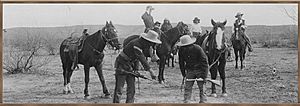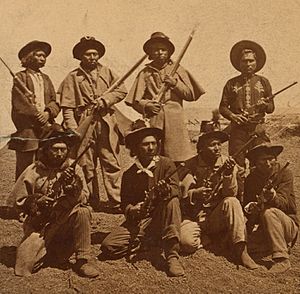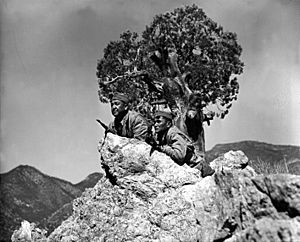United States Army Indian Scouts facts for kids

Native Americans have played a big part in U.S. military conflicts since the country began. Early colonists asked for help from Indian allies during wars like the Pequot War (1634–1638), the Revolutionary War, and the War of 1812. Native Americans also fought on both sides during the American Civil War. They even served in missions abroad, like the famous Codetalkers in World War II.
Indian Scouts were very active in the American West in the late 1800s and early 1900s. Some even went with General John J. Pershing into Mexico in 1916 to find Pancho Villa. The official Indian Scouts program ended in 1947 when the last scout retired from the Army at Fort Huachuca, Arizona. For many Native Americans, being a scout was an important way to interact with White American culture and learn new ways of thinking.
Contents
Joining the Scouts
The idea of having Indian scouts was first approved by the U.S. Congress on July 28, 1866. This law allowed the President to hire up to 1,000 Native Americans as scouts. They would be paid like cavalry soldiers.
There were different kinds of scouts. Some joined the Army as official "Indian Scouts" for short periods. Others were simply hired by the U.S. Army for specific tasks. Sometimes, a person might have been both a hired scout and an enlisted scout at different times. Before 1866, these scouts were seen as employees, not soldiers.
Scout Uniforms and Skills
After 1866, officially enlisted Indian scouts received old Army uniforms. They often wore these uniforms mixed with their traditional Native clothing. For example, in 1870, an Army captain described Apache scouts in Arizona wearing mostly loin-cloths, moccasins, and hats with hawk feathers. Later, in 1902, new rules gave U.S. Scouts a more official and regulated uniform.
During the Indian Wars after the U.S. Civil War, Indian scouts were incredibly valuable to the Army. They were fast, brave, and knew the land very well. They didn't always follow strict Army rules, but they were experts at traveling long distances across the American West. They also provided important information and often led the way in battles against other Native American groups. A Pawnee Scout leader named Luther H. North once said, "Neither the Wild Tribes, nor the Government Indian Scouts ever adopted any of the White soldier's tactics. They thought their own much better."
In 1892, Lieutenant Hugh L. Scott created Troop L of the 7th Cavalry Regiment at Fort Sill, Oklahoma. All the soldiers in this troop were Indian Scouts. This troop served until 1897. Scott later became a major general and even served as the Chief of Staff of the United States Army. The very last group of Indian Scouts served at Fort Huachuca, Arizona in 1942.
Amazing Tracking Skills
Indian scouts had incredible tracking abilities during the Indian Wars. They could spot horse tracks on hard ground where other soldiers saw nothing. From these tracks, scouts could guess how many horses were in a group. They could even tell how old a trail was by checking the moisture in horse droppings. Scouts could also figure out if women were riding with a group based on where a horse's urine was in its tracks. This was because women sometimes rode female horses (mares), while men rode male horses (stallions).
Challenges Faced by Scouts
Sometimes, there were worries about whether Indian Scouts would stay loyal to the U.S. Army. The Cibicue Apaches were some of the first regular Army Scouts. They were also involved in the only known event in the 1800s where Indian scouts turned against the U.S. Army. This happened at Cibicue Creek in Arizona. These Apache scouts faced a very difficult choice when they were asked to fight against their own relatives. This led to a serious incident where some scouts turned against the army, and some faced severe punishment.
Fewer Scouts Needed
As the fighting on the frontier ended, fewer Indian scouts were needed. In 1891, the Army reduced the number of scouts from 275 to 150. These scouts were spread out across different areas. Later, in 1898, the number of authorized Indian Scouts was reduced even further to just 75.
Indian Scouts and their widows became eligible for pensions (regular payments) starting in 1917. This was for their service in the American Indian Wars from 1859 to 1891.
Famous Indian Scouts
Scouts on the frontier came from many different backgrounds, including Black, Native, and mixed-heritage individuals. Native Americans from various tribes across the United States served, such as the Narragansett, Mohegan, Apache, Navajo, and later, Alaska Natives.
One of the most well-known U.S. Army Indian Scouts was Curley, a member of the Crow tribe. He became a scout in 1876 and later joined Lieutenant Colonel Custer. Curley is often remembered as the only survivor of "Custer's Last Stand." However, he said he did not actually see the battle.
The official website of the Navy lists American Indian Medal of Honor recipients. The Medal of Honor is the highest military award in the U.S. It is given for incredible bravery "above and beyond the call of duty." Twelve Native Americans received this honor in the 1800s, and five more in the 1900s.
While less information is available, Native American women also helped the military. For example, Tyonajanegen, an Oneida woman, and Sacajawea, a Shoshone, aided the military as far back as the American Revolution.
Sergeant I-See-O (born around 1849) was a Kiowa man who served as an Indian Scout from 1889 until he passed away in 1927. He served with future Army Chief of Staff Hugh L. Scott. In 1915, Scott convinced Congress to let I-See-O stay on active duty for his entire life. I-See-O lived in a teepee in a quiet part of Fort Sill, Oklahoma in his later years. He was even a guest of President Calvin Coolidge at the White House in 1925.
Scout Insignia
In 1890, Indian Scouts were allowed to wear the branch insignia of crossed arrows. This symbol was later used by the 1st Special Service Force in 1942. As their traditions continued into the U.S. Army Special Forces, the crossed arrows became part of their official insignia in 1984.
Medal of Honor Recipients
The following 16 Indian Scouts received the Medal of Honor:
- Sergeant William Alchesay
- Blanquet
- Chiquito
- Sergeant Co-Rux-Te-Chod-Ish (Traveling Bear)
- Elsatsoosu
- Pompey Factor
- Sergeant Jim
- Kelsay
- Kosoha
- Machol
- Nannasaddie
- Nantaje
- Adam Paine
- Isaac Payne
- Yuma William "Bill" Rowdy
- Sergeant John Ward




